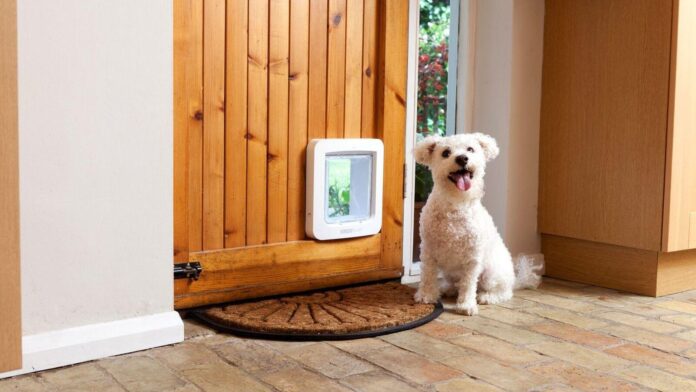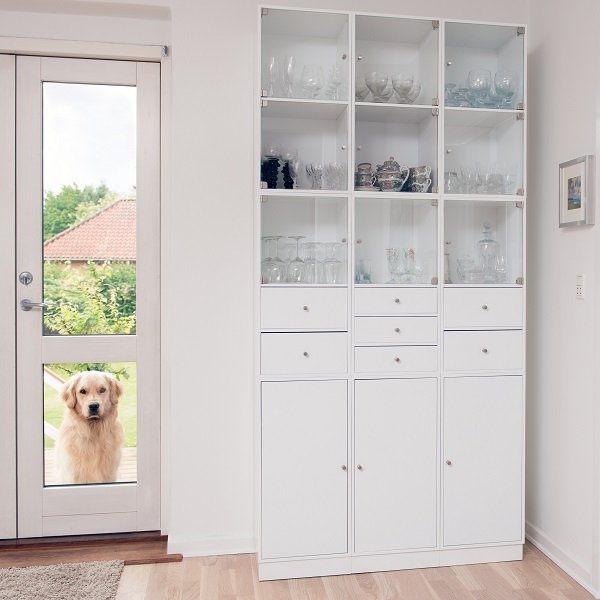Once upon a time, a savvy pet owner said enough is enough when it comes to getting up frequently throughout the day to let a dog outdoors to do its thing. The same savvy pet owner also put an end to a crying cat begging to go outside to chase the birds mocking it from the windowsill. What did the savvy pet owner do?
The savvy pet owner created the first pet door.
Let’s look at why pet doors make sense, before diving into the different types of pet doors and the best wood options for installing a pet door on a door leading outdoors.
Benefits of Installing a Pet Door
Although your pet cannot communicate its appreciation verbally, it will certainly thank you for adding a pet door because of the many benefits the door delivers on a daily basis.
Be Free My Furry Friend
If you have ever brought a dog or a cat into your home, you know about the sad look you get when your pet sits by the back door. It is a look of “I want my freedom to go in and out as I please.” Installing a pet door not only gives the power of movement to your pet, it also gives you the freedom of not having to worry about when your furry friend needs to go outdoors.
Eliminate Damage
Many pets, and not just the impatient ones, will claw and scratch doors to let their human friends know they want to go outside. Scratches on wood, metal, and vinyl surfaces degrade the quality of the door leading to the backyard. This is especially true for the highest quality of wooden doors.
Puts You in Control
Adding a doggie or a kitty door is not just about giving your pet the freedom to go outside. A pet door is also an effective way to prevent your pet from accessing the kitchen, the dining room, or the living room. Pet doors typically include a latch-type device that automatically closes shut to prevent a pet from regaining access to a space inside of your home.
Eco-friendly Pet Accessory
A pet door is much more than the gateway to the great outdoors. It is also a highly effective home accessory to control your heating and cooling bills. Instead of opening a full-length door and letting in hot or cold air, your pet simply slides through a small opening that does not usher as much hot or cold air into your home.
Types of Pet Doors
Although there a several specific types of pet doors, for this shopping guide, let’s review four of the most common types of pet doors.
Standard Flap
You have probably seen more flaps than any other type of pet door. Flaps are easy to install and maintain, as well as give your pet a virtually hassle free way to access the great outdoors. The one downside to installing a flap is that by keeping the flap open throughout the day, you run the risk of giving other types of animals easy access to your home.
Plastic Lock Door
Durable plastic is a sound option for installing a pet door. With a locking feature, you eliminate the intrusion problem caused by wild animals such as pesky squirrels and potentially dangerous raccoons. Although a hard plastic door that comes with a locking feature does limit your pet’s freedom a bit, it is a great pet door option for pet owners living in areas that bustle with wild animal activity.
Electric Door
Modern technology has changed how we view pet doors. With an electronic pet door, the door activates from a sensor located on your pet’s collar. When your dog or cat comes within a specified distance of the door, the doors opens to give your pet access to outside. You have to train your pet to use the magnetic device collar to its advantage, but the learning curve should be short lived.
Wood Doors
Many pet owners wonder if they have to replace stylish wooden doors with more durable plastic or metal doors to prevent the damage caused by pet activity. The answer is no, as wooden doors make the best doors for installing a pet door that gives your pet the utmost freedom. Wooden doors exude a stylish appearance that blend in perfectly with other accessories placed in a room, such as your kitchen or your enclosed porch.
Here is a list of the best types of wood for pet doors.
- White Pine
- Mahogany
- Reclaimed White Oak
- Sapele
- Western Red Cedar
- Spanish Red Cedar
Best Locations for Installing a Pet Door
We have established that the installation of a pet door is convenient for both you and your pet. The question now is where is the most convenient location to add a pet door? The answer depends on your home layout. You can create a space for a flap to attach on a wooden door or carve out a section of a glass sliding door that leads to the deck. Some pet owners hire a home improvement professional to install a pet door that runs through a wall. Other pet owners prefer to make installing a pet door a do it yourself project requiring a little snipping of the fine wire mesh that forms a screen door.
Wherever you decide to add a pet door, make sure it is located in an area that is familiar to your pet. Installing a pet door in the basement or in a room you never allow your pet to access dramatically diminishes the many benefits of installing a pet door.
Author Bio:
Tal Hassid has been in the door industry for over 15 years and is a home decor and door design expert. He is founder ETO Doors, manufacturer and vendor for residential and commercial doors for both exterior and interior uses.





















